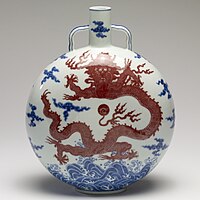
Photo from wikipedia
PURPOSE This in vitro study evaluated the color differences when discolored tooth substrates were restored with CAD-CAM monolithic ceramics depending on ceramic type and thickness, and the try-in paste shade.… Click to show full abstract
PURPOSE This in vitro study evaluated the color differences when discolored tooth substrates were restored with CAD-CAM monolithic ceramics depending on ceramic type and thickness, and the try-in paste shade. METHODS Six ceramic types were tested: high-translucent lithium disilicate (LD-HT); medium-translucent lithium disilicate (LD-MT); low-translucent lithium disilicate (LD-LT); low-translucent leucite (LC-LT); feldspathic ceramic (FC); BL1 low-translucent lithium disilicate, stained to A1 shade (LD-BL1-LT). The ceramics were tested in disc-shaped specimens with 0.5, 1.0, and 1.5mm thickness (n=10; N= 180; shade A1). The try-in pastes tested to simulate luting materials corresponded to colors A1 and opaque white (OW). Six substrates were used: A1 (reference), B2, B3, A3, C2, and C3. Color differences (ΔE00) and translucency parameter (TP00) were assessed with the CIEDE2000 formula. The results were compared with acceptability (AT = 1.77) and perceptibility (PT = 0.81) thresholds. RESULTS Ceramic type, thickness, and the try-in paste shade influenced the color differences. LD-LT and LC-LT ceramics and OW try-in paste provided, in general, lower ΔE00 values. The most adequate ceramic thickness varied according to the substrate discoloration. With 1.0 mm of ceramic thickness, it was possible to obtain ΔE00 lower than the PT for substrates C2 and A3, and ΔE00 lower than the AT for C3 and B3. ΔE00 lower than the AT were obtained with 0.5mm of ceramic thickness for B2, A3, and C2. CONCLUSION The use of low-translucent glass-ceramics and opaque white try-in paste are useful to reduce color differences. The most adequate ceramic thickness depends on the substrate discoloration.
Journal Title: Quintessence international
Year Published: 2023
Link to full text (if available)
Share on Social Media: Sign Up to like & get
recommendations!